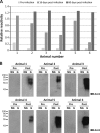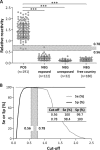A Bacterial Glycoengineered Antigen for Improved Serodiagnosis of Porcine Brucellosis
- PMID: 26984975
- PMCID: PMC4879272
- DOI: 10.1128/JCM.00151-16
A Bacterial Glycoengineered Antigen for Improved Serodiagnosis of Porcine Brucellosis
Abstract
Brucellosis is a highly zoonotic disease that affects animals and human beings. Brucella suis is the etiological agent of porcine brucellosis and one of the major human brucellosis pathogens. Laboratory diagnosis of porcine brucellosis mainly relies on serological tests, and it has been widely demonstrated that serological assays based on the detection of anti O-polysaccharide antibodies are the most sensitive tests. Here, we validate a recombinant glycoprotein antigen, an N-formylperosamine O-polysaccharide-protein conjugate (OAg-AcrA), for diagnosis of porcine brucellosis. An indirect immunoassay based on the detection of anti-O-polysaccharide IgG antibodies was developed coupling OAg-AcrA to enzyme-linked immunosorbent assay plates (glyco-iELISA). To validate the assay, 563 serum samples obtained from experimentally infected and immunized pigs, as well as animals naturally infected with B. suis biovar 1 or 2, were tested. A receiver operating characteristic (ROC) analysis was performed, and based on this analysis, the optimum cutoff value was 0.56 (relative reactivity), which resulted in a diagnostic sensitivity and specificity of 100% and 99.7%, respectively. A cutoff value of 0.78 resulted in a test sensitivity of 98.4% and a test specificity of 100%. Overall, our results demonstrate that the glyco-iELISA is highly accurate for diagnosis of porcine brucellosis, improving the diagnostic performance of current serological tests. The recombinant glycoprotein OAg-AcrA can be produced in large homogeneous batches in a standardized way, making it an ideal candidate for further validation as a universal antigen for diagnosis of "smooth" brucellosis in animals and humans.
Copyright © 2016, American Society for Microbiology. All Rights Reserved.
Figures


Similar articles
-
A bacterial engineered glycoprotein as a novel antigen for diagnosis of bovine brucellosis.Vet Microbiol. 2014 Aug 27;172(3-4):455-65. doi: 10.1016/j.vetmic.2014.04.014. Epub 2014 Apr 30. Vet Microbiol. 2014. PMID: 24984948
-
Evaluation of recombinant porin (rOmp2a) protein as a potential antigen candidate for serodiagnosis of Human Brucellosis.BMC Infect Dis. 2017 Jul 11;17(1):485. doi: 10.1186/s12879-017-2588-1. BMC Infect Dis. 2017. PMID: 28693438 Free PMC article.
-
Performance of skin tests with allergens from B. melitensis B115 and rough B. abortus mutants for diagnosing swine brucellosis.Vet Microbiol. 2014 Jan 10;168(1):161-8. doi: 10.1016/j.vetmic.2013.10.024. Epub 2013 Nov 11. Vet Microbiol. 2014. PMID: 24331743
-
Serological diagnosis of brucellosis.Prilozi. 2010;31(1):65-89. Prilozi. 2010. PMID: 20703184 Review.
-
Fluorescence polarization assay for the diagnosis of brucellosis: a review.J Immunoassay Immunochem. 2001;22(3):183-201. doi: 10.1081/IAS-100104705. J Immunoassay Immunochem. 2001. PMID: 11506271 Review.
Cited by
-
Synthetic Glycobiology: Parts, Systems, and Applications.ACS Synth Biol. 2020 Jul 17;9(7):1534-1562. doi: 10.1021/acssynbio.0c00210. Epub 2020 Jun 30. ACS Synth Biol. 2020. PMID: 32526139 Free PMC article. Review.
-
A novel multiplex and glycoprotein-based immunochromatographic serologic IgM test for the rapid diagnosis of Escherichia coli O157 and O145 causing bloody diarrhea and hemolytic uremic syndrome.J Clin Microbiol. 2024 Dec 11;62(12):e0100324. doi: 10.1128/jcm.01003-24. Epub 2024 Oct 31. J Clin Microbiol. 2024. PMID: 39480070 Free PMC article.
-
Swine brucellosis: current perspectives.Vet Med (Auckl). 2016 Dec 20;8:1-12. doi: 10.2147/VMRR.S91360. eCollection 2017. Vet Med (Auckl). 2016. PMID: 30050849 Free PMC article. Review.
-
The first study on seroprevalence and risk factors for zoonotic transmission of ovine and caprine brucellosis in the Province of Bam, Burkina Faso.Vet World. 2022 Feb;15(2):262-267. doi: 10.14202/vetworld.2022.262-267. Epub 2022 Feb 5. Vet World. 2022. PMID: 35400967 Free PMC article.
-
A recombinant O-polysaccharide-protein conjugate approach to develop highly specific monoclonal antibodies to Shiga toxin-producing Escherichia coli O157 and O145 serogroups.PLoS One. 2017 Oct 5;12(10):e0182452. doi: 10.1371/journal.pone.0182452. eCollection 2017. PLoS One. 2017. PMID: 28981517 Free PMC article.
References
-
- Diaz Aparicio E. 2013. Epidemiology of brucellosis in domestic animals caused by Brucella melitensis, Brucella suis and Brucella abortus. Rev Sci Tech 32:43–51, 53–60. - PubMed
-
- Di Febo T, Luciani M, Portanti O, Bonfini B, Lelli R, Tittarelli M. 2012. Development and evaluation of diagnostic tests for the serological diagnosis of brucellosis in swine. Vet Ital 48:133–156. - PubMed
Publication types
MeSH terms
Substances
LinkOut - more resources
Full Text Sources
Other Literature Sources

